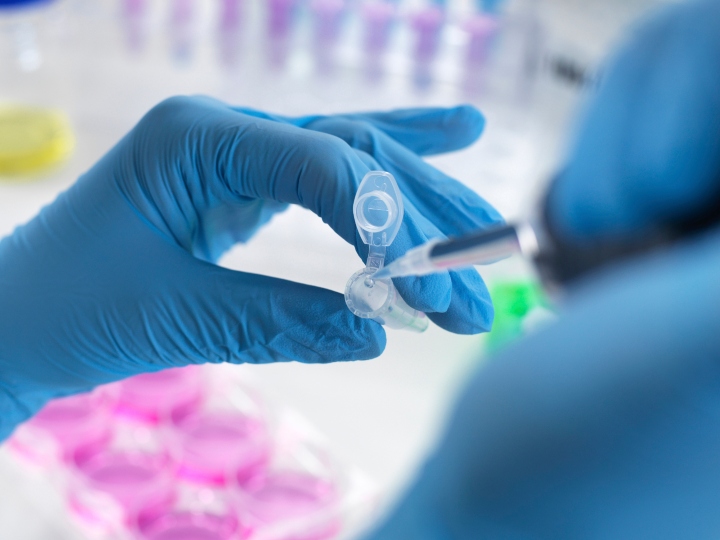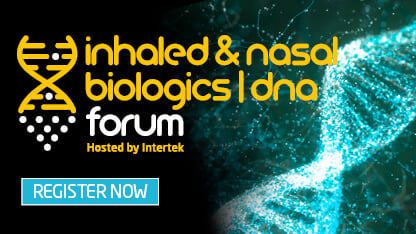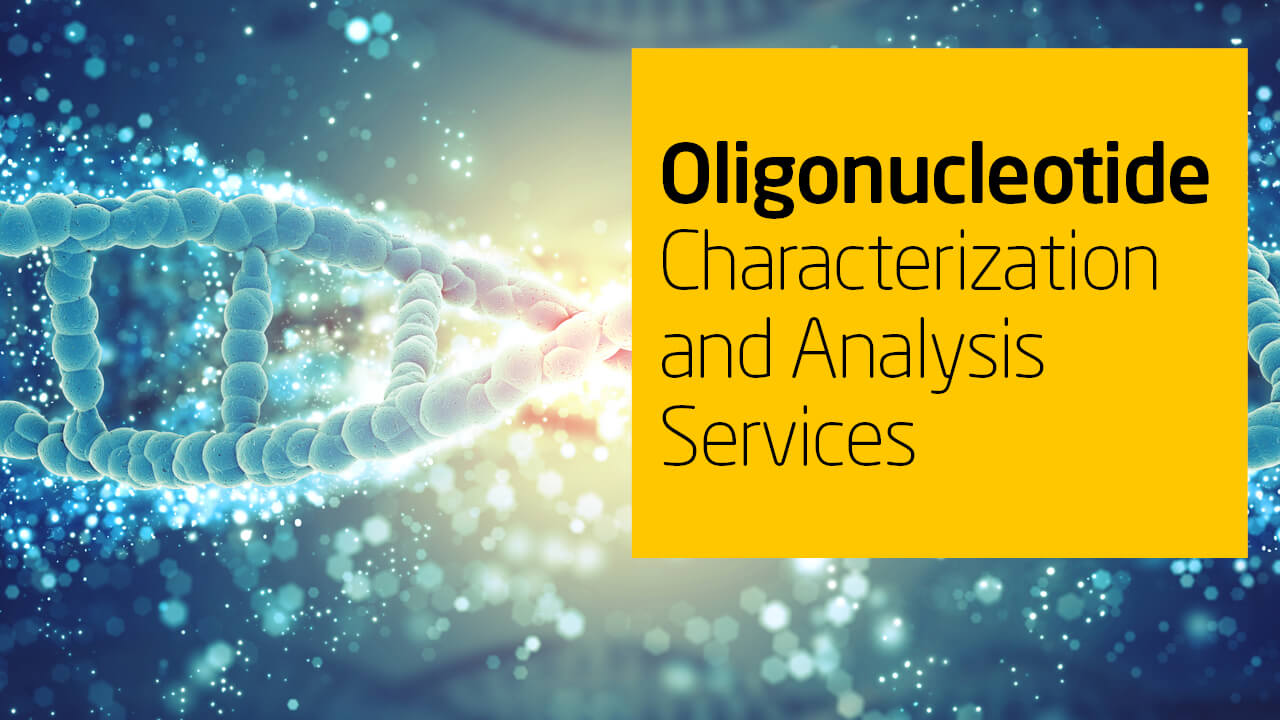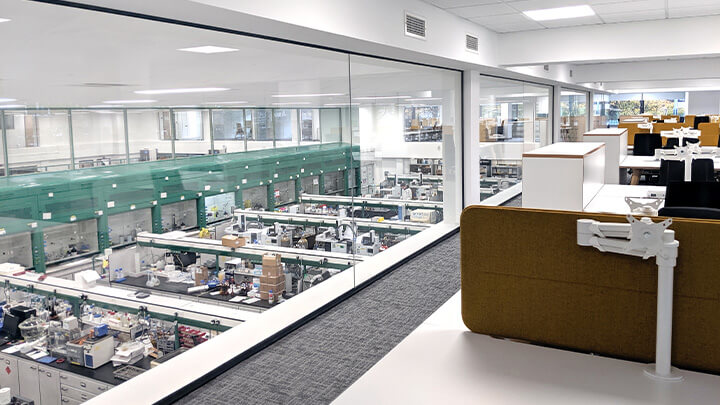Oligonucleotide characterization services to assess identity, purity, quality, strength, structure, and physicochemical properties.
Oligonucleotide characterization is a critical component of oligonucleotide therapeutic development, registration, and quality control which requires confirmation of the identity, structure, correct nucleic acid sequence and comprehensive characterization and quantification of impurities to ensure therapeutic efficacy.
Given the sheer complexity and diversity in the types of oligonucleotides (e.g. RNA, antisense oligonucleotides (DNA-like) or aptamer) in clinical development, including differences in length, chemical modifications, conjugation and other features, a range of diverse analytical approaches are required.
Among our capabilities are Good Manufacturing Practice (cGMP) characterization services for the different classes of oligo-based drugs. We determine the identity, structure, biologic potency, physicochemical properties, purity and impurities, and perform method development and validation where required to meet your drug delivery development, registration or quality control needs.
Oligonucleotide Therapeutic Physicochemical Characteristics
Our teams use mass spectrometry (MS) methods to determine the molecular weight of the oligo, typically using electrospray ionisation (ESI). High resolution accurate-mass spectrometry (Orbitrap, QToF) allows accurate mass spec data (HRAM) to be generated to support characterization requirements. We also provide a full set of physicochemical property testing, including optical rotation, pH, pKa, and moisture content.
Oligonucleotide Identity, Structure and Characterization
We apply orthogonal approaches to verify the identity of oligonucleotides, including molecular weight and molecular sequencing, as an assurance of identity of an oligonucleotide.
Molecular weight and molecular sequencing are used to verify the identity of an oligonucleotide. To confirm or determine the sequence of the oligos, we use enzymatic or chemical digestion approaches followed by mass spectrometry, including high-resolution accurate-mass spectrometry (Orbitrap, QToF).
Our expertise in 31P nuclear magnetic resonance (NMR) spectroscopy can yield powerful data about the type of internucleoside linkers (phosphodiester, phosphorothioate, methyl phosphonate, phosphonate, or any other modified phosphate), the nucleobase, and oligo backbone composition. Monitoring modifications to nucleoside linkages via NMR spectroscopy, in particular 31P NMR can deliver powerful data on the type and ratio of different types of internucleoside linkers.
Higher order structures can be evaluated by electrospray ionization mass spectrometry (ESI-MS), circular dichroism (CD) spectroscopy, and thermal denaturation measurements. Melting temperature (Tm) is a critical quality attribute of an oligonucleotide, and we monitor this using NMR and circular dichroism (CD).
Due to their impact on the structure, it is important to determine the presence of counterions, particularly for divalent ions (e.g. Mn, Ca, Cu, Zn, Mg, Fe, etc). We use inductively coupled plasma spectroscopy (ICP-MS or ICP-OES) to achieve elemental information and trace metal levels.
Purity and Impurities Analysis for Oligonucleotide Therapeutics
To understand the purity of the oligonucleotide, we provide drug substance and drug product assays and can build a well-understood impurity profile by applying a range of chromatography (e.g. UPLC, HPLC, LC-MS, CGE) and spectroscopy methods (UV absorbance spectrum, extinction coefficient, FTIR, 13C and 1H NMR).
Determining the levels of product-related impurities such as addition sequences (n+1, n+2, etc.), deletion sequences (n-1, n-2,etc.), we apply HPLC with UV and MS detection approaches.
For other product-related species such as phosphodiester analogs, depurinated sequences, partially deprotected sequences, and aggregated sequences, we apply a combination of chromatographic (e.g HPLC) and spectroscopic (e.g 31P NMR) methods. Our scientists also deliver highly detailed MS characterization of product related impurities using QToF, MALDI-TOF MS, ESI-MS, LC-MS, LC-MS/MS with expert data interpretation to determine the levels of early and late eluting impurities.
Determination of process residuals (residual solvents, trace metals) and other reagents (e.g. activators, deprotection agents, trace levels of EDTA) that may be present in the sample are also achieved through a combination of chromatographic and spectroscopic methods.
Supporting Oligonucleotide Therapeutic Development
Our scientists have supported oligo medicine drug development since the inception of this class of therapeutics. Through our dedicated suite of characterization techniques, we are focused on helping you to meet industry requirements for regulatory compliant (GMP or GLP) characterization and quality control for oligonucleotide-based drugs. Bringing quality and safety to life, our Total Quality Assurance services are delivered consistently to help you ensure you meet and exceed your quality, safety, and efficacy requirements.
You may also be interested in: oligonucleotide analysis support services

COVID-19 VACCINE OR THERAPEUTIC TESTING & DEVELOPMENT SUPPORT
IMMEDIATE QUESTION? Ask our experts now
FACTSHEET: COVID-19 Vaccine or Therapeutic Testing & Development Outsourcing
ARTICLE: Repurposing Vaccines for Intranasal Development
WEBINAR: Quality Control Strategy for Vaccine Development
WEBINAR: Repurposing Drugs for Inhaled Delivery
eBOOK: Contingency Outsourcing Solutions

Pharmaceutical News & Events
- PRESS RELEASE: Lab expansion to enhance capabilities in inhaled biologics drug development
- PRESS RELEASE: Intertek partners with CrystecPharma to advance formulation science and accelerate development for dry powder inhalers
- NEW! Blog: Optimising Quality in Pharma Supply Chains
- Determination of Particles in Pharmaceuticals - Article
- Discover our Audit Live Tool for direct access to our scheduled audits
- Extractables/Leachables Lab Tour - Request access
- Medical Device Extractables & Leachables Studies
- Glycosylation Analytical Approaches for Antibody Therapeutics
- Rapid Determination of Low/Trace Level Benzene in Pharmaceutical Excipients and Finished Products
WEBINAR: Designing a QC Strategy for mRNA Vaccines
CASE STUDY: CMC Considerations for mRNA Based Therapies
SPECIAL REPORT: Analytical Challenges - Characterisation of Oligonucleotide Therapeutics
PRESENTATION: Data Analysis for CMC Testing of Oligonucleotides
CASE STUDY: Determination of Melting Temperature for Oligonucleotide Duplexes using NMR
CASE STUDY: Identification Testing by Accurate Mass and MS/MS Sequencing
ARTICLE: Physicochemical Properties of Liposomal Advanced Drug Delivery Technologies
CASE STUDY: CMC Considerations for mRNA Based Therapies



